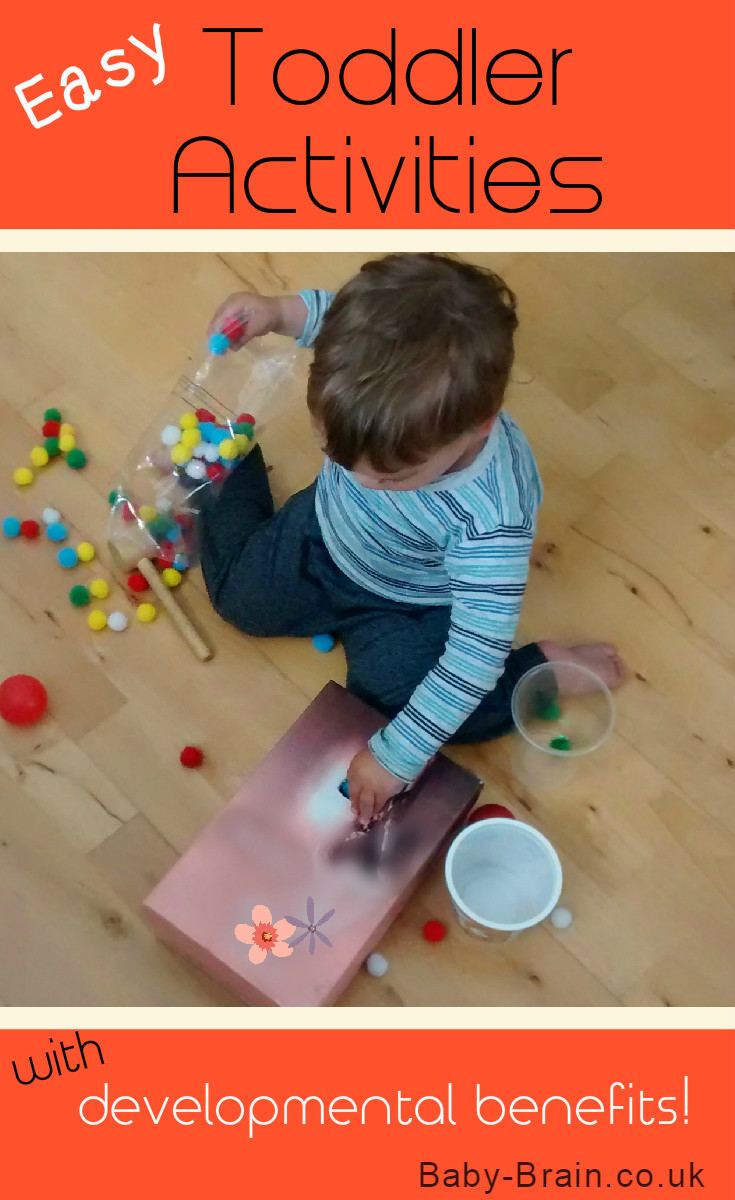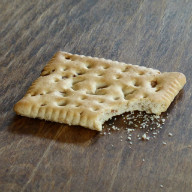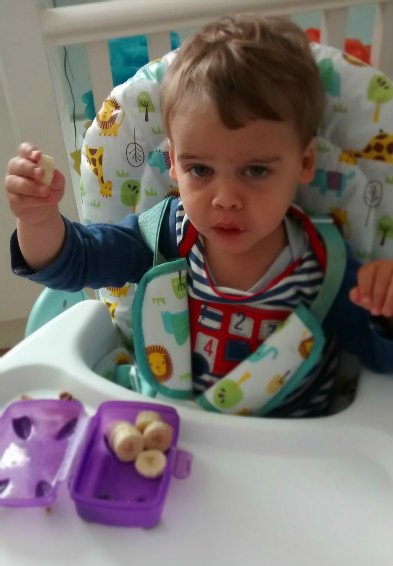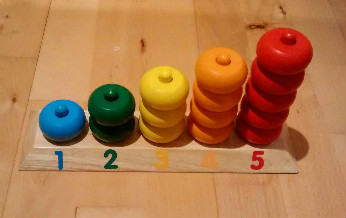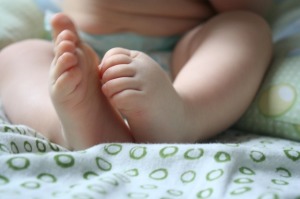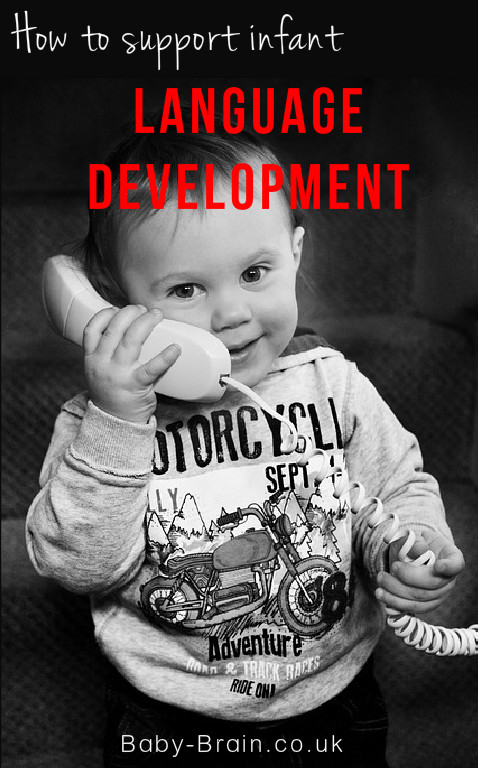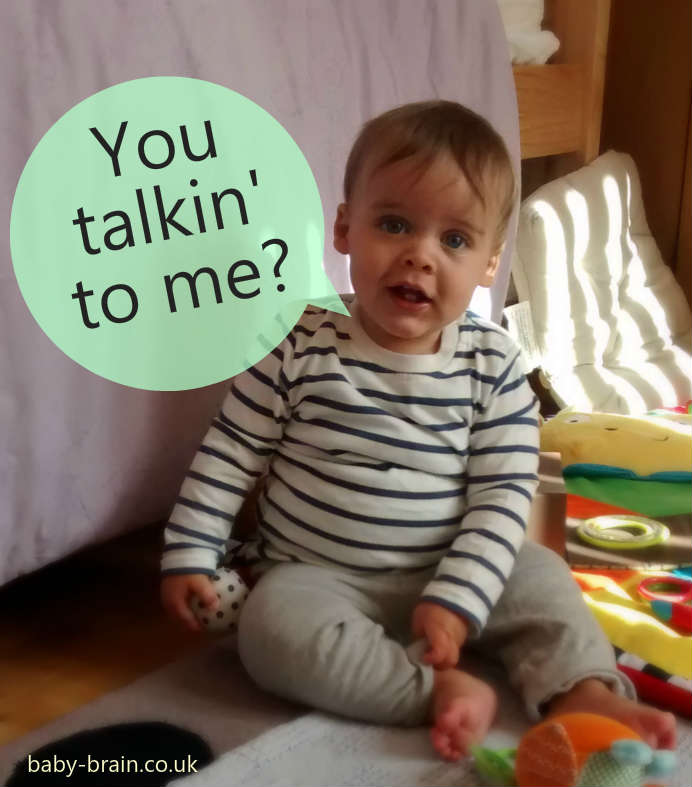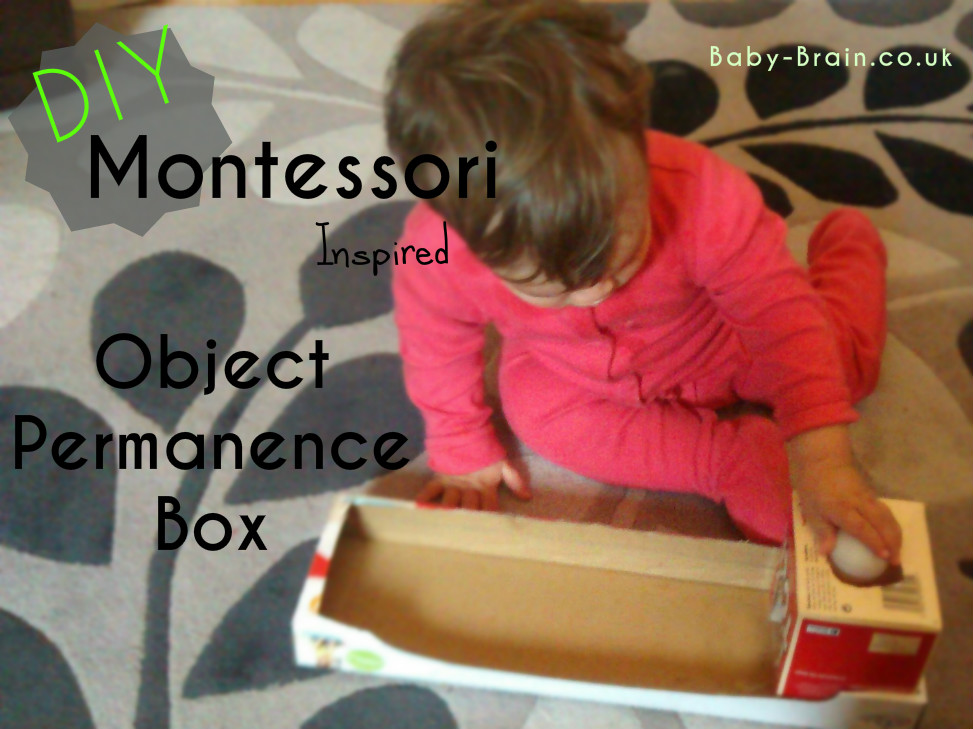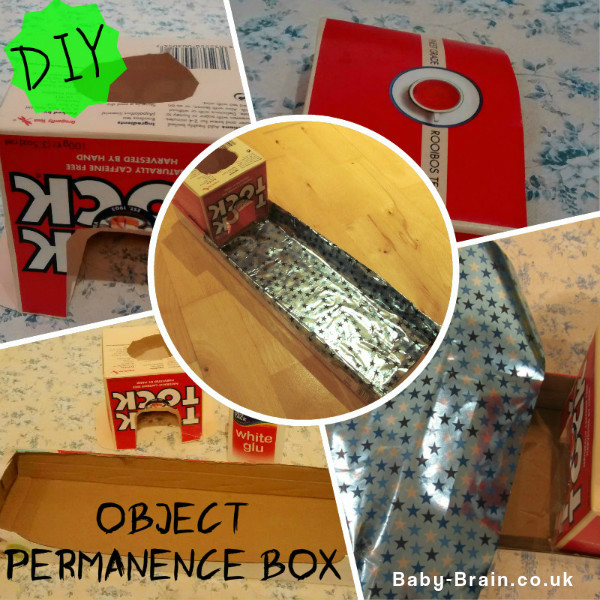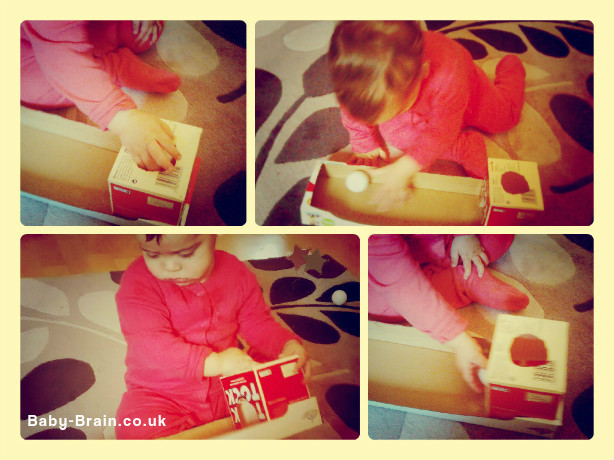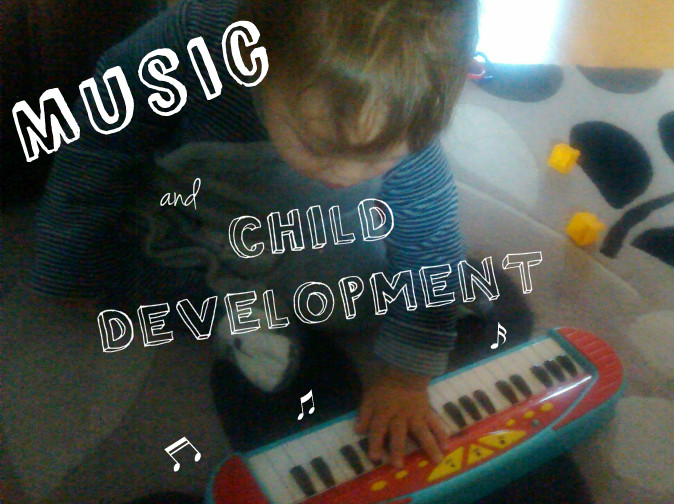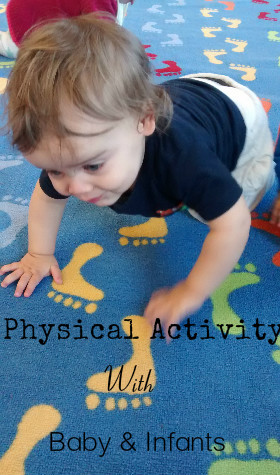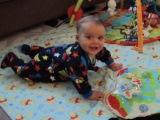Development
Verbal progression (19 months)
We have progressed from saying “Mumma” and “Dadda” to Mummy and Daddy (but only some of the time). And, more importantly, from “bis” (for biscuit) to…. BIKKIT! Yeah (aged 19 months). Now just need to wait for proper biscuit pronunciation.
We also had a longer sentence uttered to day – He asked “mumma hold the car”, whilst eating his dinner (wanted me to hold his toy car). Very good, although he forgot to call me mummy!
We are 18 months old! Child development and update at 18 months
 We are one and a half years old! Time has gone quickly; it doesn’t seem like that long ago I was planning his little first birthday get together.
We are one and a half years old! Time has gone quickly; it doesn’t seem like that long ago I was planning his little first birthday get together.
What have we noticed? Well in the last few weeks he’s:
-
Been using more than one word at a time and
-
Making small sentences.
For example, he might say “off the bus”, or “kiss owl” (kiss his toy owl).
-
He can also repeat short sentences and strings of 2 or 3 words that I say to him, although I don’t know how much he understands as it’s only repetition and not generated by himself in context. But, that said, this seems different because recently he’d only say one word at a time.
Typical developments at 18-24 months:
This timeline of typical development from birth to five years old from the NHS outlines skills and milestones at different ages. There’s also a link to an article from the Zero to Three website on their page here on child development at 18-24 months, what your toddler can do and how to support emerging skills.
 According to the NHS:
According to the NHS:
-
Apparently it’s typical at 1.5-2 years old for children to start to put at least 2 words together.
-
At this age toddlers will also learn to kick or throw a ball.
That’s great because we’ve signed up for football classes and have been going for a few months. Initially he wasn’t kicking the ball but was picking it up and putting it in the goal (at least he understood the concept). But more recently he has been able to kick the ball, plus we’ve been out with the ball at the weekends too, which I think has helped because of the added practice of those motor and coordinator skills.
-
From 1.5 to 4 years children start to develop bladder control
We bought a potty but haven’t started any potty training yet. For a month or even two now he’s been able to tell us when he’s done a poo which I assume means that he is more aware of his bodily functions and can communicate that. My plan is to buy a story book about using a potty to start to introduce the concept to him. I don’t know if he can tell us in advance yet that he needs to do a poo. We haven’t discussed that with him but I suppose I could start talking with him about “tell me if you need to do a poo”, or something, and reinforcing or rewarding if he says something.
Zero to Three write that
-
at 18-24 months toddlers are starting to use their imagination, e.g. feeding a toy pretend food, making car noises when playing with cars
I’ve definiately noticed this. The Little Lovely has “fed” his milk to some of his toys before. Not sure we’ve heard car noises though. Extend on these skills by pretend and imaginative play!
I’ve noticed increased “obstinate” behaviour!!
OK, not a fair way of putting it, but what I mean is that when I ask LL not to do something, he pauses and does it anyway, like “drop” his food on the floor (he throws it sometimes, but then looks up and says “dropped”), or touch on the television screen. I repeatedly ask him not to do it and issue a consequence like turning the television off (*gasp*, yes, we watch some television) and asking him to pick up the food off the floor and put it in the bin (which he does). But he still repeats the same behaviour.
-
Apparently at this young age he might understand what i’m saying, but not have the self control to do much about it (according to the Zero to Three handout on 18-24 month old development). And this is a skill that can take some time to develop. I guess I’ll have to remain consistent, firm, and give clear instruction and consequence anyway.
For other areas of development at 18-24 months (and from prenatal to 36 months old) see this brilliant “baby brain map”, (zero to three) that outlines different areas that are developing in the brain (e.g. social and emotional) at this time.
Baby talk – helping infants and children with speech
16.5 months – we are copying a lot more words. Yesterday he learnt to say “cheese”, and “ring”. He can copy quite a few words now and use them appropriately. For example, today he went to the fridge, found the cheese and asked for cheese.
He doesn’t always pronounce everything “right” though. I’ve also noticed him trying to “talk” by saying nonsense words, with the odd real word in there like “bus”, usually relating to something we’ve just been playing with or is in front of him (e.g. toy bus).
What should I expect of baby talk?
-
The NHS has a nice page here on helping your child’s speech.
Verbal communication and all those other related skills (non-verbal, facial expression, gesture, words, etc) are SKILLS. Babies and infants need to understand communication and words before they can learn to use these skills themselves. How can you teach and build these vital skills with infants? The site above writes:
You can help your child learn by holding them close, making eye contact and talking to them as soon as they’re born.
They will look back at you and very soon begin to understand how conversations work.
Even making ‘baby noises’ will teach your baby useful lessons about listening, the importance of words and taking turns in a conversation.
When baby gets a bit older and starts to notice and take interest in their surroundings:
Start naming and pointing at things that you can both see (‘Look, a cat!’). This will help your baby learn words and, in time, they’ll start to copy you.”
Putting words together:
We haven’t started this yet, but apparently it doesn’t happen until around age 2, when toddler can say around 100 words.
Other baby talk tips:
-
From day one – asking questions such as, “are you hungry?” or “would you like some milk?”
-
When you’re out with baby or around the house – pointing out objects and saying things such as “look, there’s a dog!”
-
If baby can partly say a word, e.g. “poon” (spoon), then repeat the word in it’s correct form – “yes, spoon”, rather than copy baby so that they can hear the full pronunciation
-
Give baby choices and questions to increase their vocabulary such as “would you like a strawberry yoghurt or an apple”
Concerns about your child’s speech?
This website, Talking Point, has a lot of information about children’s communication, broken down into ages and stages from 0 to 17 years old, such as this page here about development at 12-18 months.
They also have “progress checkers“, such as the one here for 12 month olds, and one for 18 months old (other ages available), that asks a series of questions about what baby can do.
- For the progress checker please note they write that: “This Progress Checker has been written by speech and language therapists, based on typical developmental milestones – It is intended to be used as a guide only. No diagnosis can be made as children are not seen face to face – It is possible that concerns may be highlighted when there are not issues with children’s speech and language. If in doubt, check with a health visitor or speech and language therapist – If your child has just had a birthday, you might want to look at the age-group younger than them. Similarly, if your child is coming up to a birthday, you might want to check the age-group older than them.
So enjoy a nice little chat!
better motor skills – updates at 16 months old
We are nearly 16 months old.
What have we noticed? Well in the last few days it seems like his motor skills and abilities have really improved. Maybe they actually levelled up a while ago, but I didn’t notice. I’ve noticed increased spoon related abilities in particular. He was never so great at getting food on the spoon in the past; he could direct the food into his mouth ok if you put some on the spoon for him, but he wasn’t able to scoop much up independently. He more kind of just poked the spoon into the food or rammed it into the bowl in the hope that something would stick to it. This worked ok for something like thick yoghurt, but less so for scooping scrambled eggs or less sticky food. Anyway, more recently he’s developed some good scooping and spoon action.
He’s also able to coordinate himself with this game of putting wooden counters onto pegs (increased hand eye coordination), whereas previously he was able to get the counters off the pegs, but was less successful in threading them back on.
Unsure why the “sudden” change. Maybe it’s about that time, but it’s great because it means more independent eating skills for me so I can get on with doing some things around the kitchen while he eats! We are still rather messy with the yoghurt, however.
More on child development milestones: Here’s a nice, interactive birth to five years old development timeline from the NHS:
“An interactive guide to child development from birth to five years old, including videos and advice to help parents along the way”.
Includes information and ages you might expect certain skills and developments including walking alone (10-18 months), eating solids, taking an interest in words (12-18 months), learns to hold a crayon, and so on.
Update on our week and development at 13 months – talking, walking, accents
We are into the 13th month. What has the Little Lovely (LL) been doing?
He started walking about a month ago, with his hand being held and then independently. Before he turned 1 we saw maybe 1 little step a couple of times. Then a few weeks later a definite series of 3 steps or so, which turned into more steps and then he just decided he would walk. I wonder if it was a confidence thing because he could walk with two or one hand being held but wasn’t able to do it alone. Now he is walking quite a bit, not very fast and with a slightly awkward gait and leg position, bit like a cowboy but he is probably walking more than crawling to get places he wants to go.
He also decided to dive head first onto the floor few days ago. Not from very high but resulted in a slight bruise. We called the NHS helpline on “111” (when you need help and advice but it’s not an emergency) and they were semi-helpful, if not a bit “automated”. I think the 111 number involves call centre staff who go through a series of prescribed questions with you over the phone, but they might not necessarily be highly medically trained. Anyway, he’s all ok but was an unpleasant experience.
We are also talking more and he has added more words to his vocabulary. There is a lot of gobbledegook but no string of real words yet, or even two real words linked together, only single words. His favourite word at the moment is “bath”. “Bus” comes second. He can also say toes, and point to them, and this morning was able to repeat “Kirk”, and “Spock” when watching Star Trek. He has a strange, possibly twang of northern accent for some reason (we don’t have one), for example, he says “baath” (rather than barth), “turrs” (rather than toes), “turst” (toast) and “shurrs” (shoes), that I can think of off the top of my head.
Which makes me wonder, do babies speak with an accent?
Well, we don’t have this odd northern accent so i’m not sure where he gets it from, I think it’s just the way he is able to pronounce certain syllables at the moment and possibly about the maturity of his palate as he is still quite young. Once things flow a bit smoother verbally maybe it will change. Looking into this a bit more, however, this article from the BBC writes about research that looked at “cry melodies” in newborns and found “clear differences in the shape of the infants’ cry melodies that corresponded to their mother tongue”. Further:
Babies begin to pick up the nuances of their parents’ accents while still in the womb
The reason for this?
They say the babies are probably trying to form a bond with their mothers by imitating them… “Newborns are highly motivated to imitate their mother’s behaviour in order to attract her and hence to foster bonding”…
…This is really interesting because it suggests that they are producing sounds they have heard in the womb and that means learning and that it is not an innate behaviour.
Interesting. Also, they suggest the “cry melodies” were shaped because “melody contour” might be the only aspect of the mother’s speech that a newborn is able to imitate at their stage (as vocal control does not develop until later).
Older babies at one year also “acquire the specific accented sounds of their parents and…the first year of listening makes a lasting impact on the way we speak for our entire lives”, according to research by Professor Patricia Kuhl, as discussed briefly here.
Babies and infants then do pick up on accents and nuances of their parent’s pronunciations. But, we might have to wait a bit longer to see what kind of accent LL develops.
Baby’s first words and speech development
What was your child’s first word? What words are “normal”?
This article discusses: first words – speech development at 6-12 months and 0-6 months, tips to support and encourage development at 12 months, the importance of talking to and around infants
Just came across this list of first words with examples from a number of children, and the story behind them. Here are a few:
-
Oscar – Oscar is the cat next door. When Oscar comes in to the house, he always says ‘hello’ to the baby
-
Pop – When a balloon she was holding burst she copied the word pop
-
Book – As her parents used to look through books with her and repeatedly tell her what they were
-
Duck
-
Quack quack– baby started saying quack quack when her parents played with her rubber duck in the bath. Now she gets very excited whenever she sees ducks or chicks in books
-
Hat – As she loved putting on hats
-
Bear – As mum’s old bear was always on her bed
-
Fish – He loved watching fish in his friend’s aquarium
-
Samich (sandwich)- His mother was standing at the kitchen counter right beside him when baby reached up and said “samich”
So looks like first words can really vary. I think that the Little Lovely might have said “dada” first, but also he was saying a few other things like “kiss”, and “fish” because we went to an aquarium and I kept saying look at the fish, the fish, a lot. By the end of it, he was saying fish. Quack was also an early favourite.
Monitoring and encouraging first words
Baby’s First Word – an initiative from the National Literacy Trust (see the Words for Life website) – you can download a pack from here that has a series of templates to monitor first words and more information. The pack includes:
Everything you need to get involved in Baby’s First Word, including a step-by-step guide, poster and hand-out for parents.
How does speech develop?
Talking Point, a site that gives some good information and resources on children’s communication writes that children develop skills at their own pace but some general things that you might see between 6 months and 1 year are that children will:
- Listen carefully, and turn to someone talking on the other side of the room.
- Look at you when you speak and when their name is called.
- Babble strings of sounds, like ‘no-no’ and ‘go-go’.
- Make noises, point and look at you to get your attention.
- Smile at people who are smiling at them.
- Start to understand words like ‘bye-bye’ and ‘up’ especially when a gesture is used at the same time.
- Recognise the names of familiar objects, things like ‘car’ and ‘daddy’.
- Enjoy action songs and rhymes and get excited when sung to.
- Take turns in conversations, babbling back to an adult.
How to encourage and support your child 12 months:
encourage your child at this stage:
- Make different sounds to interest your child. This can be the sound of your voice or things like a rattle or squeaky toy.
- Pointing to sounds will help develop your child’s listening skills. This will also help their awareness of the world around them.
- Encourage your child to look at you during activities. This could be dressing, feeding or nappy changing. This will help your child’s attention and communication skills.
- Talk about everyday activities, like getting dressed, eating and bathing.
- Copy your baby when they are babbling. This is a very good way to show how to take turns in communication. This will encourage them to make even more sounds.
- Use actions with words. Try waving as you say ‘bye-bye’ or picking up their cup as you say ‘drink’. This will help your child to relate what they see and do with language.
- Sing action songs and play games like ‘peek-a-boo’ to encourage communication and attention skills.
- Have some special time with your child each day to play with toys and picture books.
Talking about everyday activities with babies is important.
Research (1) has also shown that while reading to baby and showing them pictures did contribute to cognitive development in terms of increasing scores on problem-solving and communication scales of a test, more substantial effects were found for:
the more informal activity of frequently talking to the infant while doing other things; and this was observed for both communication and problem-solving.
Reading was shown to increase both problem-solving and communication, showing pictures only had a positive effect on communication scores, but talking had a more substantial effect than both reading and picture showing.
But will baby understand when I talk to them?
Babies at 6 months have been shown to understand that concept of speech (2) – i.e. that speech is used to communicate information (rather than random, interesting sounds that come out of our mouths). They also prefer speech over other sounds (3)
Younger babies
How children develop speech and language between 0 and 6 months (quote from talking point)
by 6 months, usually children will:
- Turn towards a sound when they hear it.
- Be startled by loud noises.
- Watch your face when you talk to them.
- Recognise your voice.
- Smile and laugh when other people smile and laugh.
- Make sounds to themselves, like cooing, gurgling and babbling.
- Make noises, like coos or squeals, to get your attention.
- Have different cries for different needs. For example one cry for hunger, another when they are tired.
How to support the child at this stage:
-
Mirror/copy the sounds baby makes – it’s the start of a conversation and will encourage more sound making
-
Ensure baby can see your face clearly when you talk to them. Newborn visual range is not that great and vision is developing the first months, so maybe move a little closer to talk to them. Eye contact is important for language development.
-
As with 12 month olds, talking to baby about what you are doing is important as they will hear and start to learn words.
-
I didn’t even know my Little Lovely was paying attention until one day he copied a word that I had been saying, or I was talking about brushing my hair and then he made a motion on his own head like he was brushing his hair. He was listening to me, all along but with no verbal feedback from him before that point, I didn’t realise just how much he was taking in.
-
-
Talking point suggests using a “sing-song” voice with baby to keep them interested in what you are saying. An article on music and child development that baby-brain wrote recently also highlighted the usefulness of singing with baby:
-
Singing is important for vocabulary development: “Singing songs teaches children about how language is constructed. When you sing, words and phrases are slowed down and can be better understood by your baby. Singing regularly will help your baby to build up a vocabulary of sounds and words long before they can understand the meaning”, according to this article from the BBC.
-
Some links to other resources
Talking Point website
Talk to you baby – from the Words for Life website
More tips here, from the NHS on “helping your child’s speech”.
A video from the NHS on “how can I help my child to start talking? (12 to 30 months)”
References:
- Murrary, A., & Egan, S. (2014). Does Reading to Infants Benefit their Cognitive Development at 9-months-old? An Investigation using a Large Birth Cohort Survey. Child Language Teaching and Therapy, Vol. 30, No. 3, October 2014, pp.303-315
- Vouloumanos, A., Martin, A., & Onishi, K. H. (2014). Do 6-month-olds understand that speech can communicate? Developmental Science, pp 1–8
- Vouloumanos, A., & Werker, J.F. (2004). Tuned to the signal:the privileged status of speech for young infants. Develop-mental Science. 7 (3), 270-276
DIY Montessori Inspired Object Permanence Box for baby & infants
Do-it-yourself Object Permanence Box for infants: Inspired by Montessori materials.
-
This is practically free to make. You just need some cardboard, glue or tape, and a ball
Inspired by Montessori materials and activities, I’d always wanted an object permanence box but didn’t really want to spend £40 or so on the wooden box. So – I decided to try and make one out of cardboard and old boxes and it seemed to work. My Little Lovely (LL) really enjoys using it, putting the ball and other items in the top, exploring the box and seeing what happens if he puts the ball in the other hole.
Aims of the object permanence box: The infant has to drop a ball into the hole in the top of the box. The ball is then not visible for a moment but rolls out of the box onto the tray. The child therefore experiences a lesson in “object permanence” because they see that the ball didn’t just disappear out of existence – even though they couldn’t see it for a second, it still exists
Other learning benefits of the box: encourages curiosity, cause and effect, hand movements and fine motor skills (dropping the ball into the hole, etc), achieving a goal independently with repeated practice.
When to use the box: From when babies are old enough to sit up without support.
Here’s a short video of what the real deal looks like, as used by a 9 month old, and another of a child at nearly 1 year
Psychology & Object Permanence: Object Permanence is an awareness that children develop where “out of sight” does not mean “out of mind”. Initially, when something is removed from view of the baby then from their understanding it ceases to exist – they can’t see it, so it doesn’t exist. Understanding that something exists even when you can’t see it is an important developmental stage, according to the Stages of Cognitive Development as posed by Jean Piaget, an eminent and Swiss psychologist. It is posed as a stage in development because it requires the child to form a “schema”, or mental representation of the object. Infants develop this skill by the end of the “sensorimotor stage”. It was thought to develop around 8-12 months, although there is research to suggest it can develop earlier, and the psychological research does not seem to agree on exact age.
How to make the box:
1: I found a long cardboard box and cut some of the sides down so that I had a long, not too deep tray for the ball to run into and be contained.
2: An old tea box looked good for the little box to house the ball. I cut a hole in the top and on the front for the ball to run out of.
3: The ball needed a bit of help rolling out of the tea box and onto the cardboard tray so I made a little ramp (otherwise the ball just sat in the box after being dropped in and didn’t roll out). This was actually part of the lid from the tea box and was already slanted so I didn’t need to do much to it.
I then slotted the ramp into the tea box and glued the tea box onto the long box. You might be able to see in picture 2, there are some little flaps on the bottom of the box on each side. This was quite helpful and I put the glue on these flaps then pressed it down onto the long cardboard tray.
4: I realised that the box was looking a bit DIY so for some reason I decided to make it look more hideous by adding some wrapping paper.
5: et voilà – here is the finished box (not particularly Montessori style with the wrapping paper)
-
If you would like to make your box look more hideous with wrapping paper like I did, I would not recommend anything too busy like the one I used. Maybe just some plain, nice calming colours?
-
If I made it again I would also probably find a slightly bigger box for the ball to drop into. The tea box was ok but the ball rolled out of it pretty quickly, so maybe something a bit bigger might have held the ball out of sight for slightly longer. The tray is also slightly long, but I was using materials just hanging around the house that were waiting to go for recycling so I had to make do with what was available.
How to use the box with baby:
I quote from a Montessori site:
Presentation of the Montessori Object Permanence Box
1. Put the work mat in place and put the object permanence box on the work mat so it will be in front of the child. Encourage the child to help.
2. Sit facing the child with the work mat between you.
3. Name the box and the ball: “This is the box. This is the ball.”
4. Slowly and deliberately place the ball in the hole.
5. When the ball rolls to a stop in the tray, smile and pick it up.
6. Repeat the action.
7. Invite the child to place the ball in the hole.
8. Once the child begins putting the ball in the hole, quietly move aside and allow her to work undisturbed.
9. When finished, invite the child to put the materials away on a low shelf so she may work with them again when she wishes.
And here we are experiencing the box:
(age 12 months)
Apologies to Montessori enthusiasts – I know that you value natural materials like wood, but i’m not a carpenter and couldn’t make a box out of wood. I also know that adding wrapping paper doesn’t make it look too natural. But, hopefully I’ve captured the essence of the box, the principles and learning benefits for the child, and made an accessible and cheap alternative that can be put together easily at home.
Music and child development
How does music benefit children? What is the psychological research?
What are the benefits of babies and children playing music?
-
Social Development: music classes and playing music with babies and young children is going to involve a parent and probably other children too. The social elements of this (for parents too) are important. Also, turn taking, expression through a medium other than speech, and just having fun are going to be important elements. See the research below for findings that support the importance of interactive music making with baby.
-
Physical Development: playing an instrument requires good motor skills, both gross and fine. Baby bashing on a drum or shaking a rattle is an example of gross skills and more fine skills might come with pressing a key on a keyboard, or accurately hitting a note on a xylophone. Playing an instrument might also improve control and coordination skills in older children (see research below).
-
Psychological Development and Awareness:
– Cause and effect is a good one. Baby can learn that if they do one action (e.g. shake their hand up and down while holding a rattle) they have some effect (a noise) on their environment.
– Creativity
– Awareness of self and expression – I can make this noise, and express myself through it (especially as infants can not yet verbally communicate through speech).
– Encourages self-discipline, listening and concentration skills (see more about this from the research discussed below)
◊◊◊◊◊◊◊◊◊◊◊◊◊◊◊◊◊◊◊◊◊◊◊◊◊◊◊◊◊◊◊◊◊◊◊◊◊◊◊◊◊◊◊◊◊◊◊◊◊◊◊◊◊◊◊◊
INTERACTIVE music making is important:
Research as summarized here with very young children has found that:
One-year-old babies who participate in interactive music classes with their parents smile more, communicate better and show earlier and more sophisticated brain responses to music.
The infant brain might be particularly plastic with regard to musical exposure
The children in this study attended weekly music classes over 6 months. One class involved interactive music making and learning lullabies, songs with actions and nursery rhymes. Parents and babies worked together to learn to play percussion instruments, take turns and sing specific songs.
Another class involved parents and babies playing at various toy stations with recordings in the background.
Babies from the interactive classes showed better early communication skills, like pointing at objects that are out of reach, or waving goodbye. Socially, these babies also smiled more, were easier to soothe, and showed less distress when things were unfamiliar or didn’t go their way.
Babies who participated in the interactive music classes with their parents… preferred to listen to a version of a piano piece that stayed in key, versus a version that included out-of-key notes. Even their brains responded to music differently… [they] showed larger and/or earlier brain responses to musical tones.”
While both class types included listening to music and all the infants heard a similar amount of music at home, a big difference between the classes was the interactive exposure to music.
** Therefore, the interactive nature of the music classes appeared to be important, rather than passively listening to music in the background or playing with minimal interaction between parent and child.**
◊◊◊◊◊◊◊◊◊◊◊◊◊◊◊◊◊◊◊◊◊◊◊◊◊◊◊◊◊◊◊◊◊◊◊◊◊◊◊◊◊◊◊◊◊◊◊◊◊◊◊◊◊◊◊◊
Does playing music “IMPROVE YOUR KID’S BRAIN”?
I came across this interesting article (original journal article here): Could Playing Tchaikovsky’s “Nutcracker” and Other Music Improve Kids’ Brains? – Good question? What did the research find? The main summary of the findings was:
Musical training might…help kids focus their attention, control their emotions and diminish their anxiety.
They looked at children aged 6 to 18 years old, and associations between playing a musical instrument and brain development. They used a measure of “cortical thickness”, and write that as children age, the cortex (outer layer of the brain) changes in thickness. The researchers wanted to see what impact music training would have in the cortex. Interestingly, they found that:
Music playing altered the motor areas of the brain, because the activity requires control and coordination of movement.
Music practice influenced thickness in the part of the cortex that relates to “executive functioning, including working memory, attentional control, as well as organization and planning for the future”
What are the possible social applications of this?
-
Apparently, 3/4 of high school students in the US never or rarely take lessons in arts or music. Therefore, the authors suggest that it is important to find new and innovative ways to make music training more widely available to young people, and to start this during childhood.
◊◊◊◊◊◊◊◊◊◊◊◊◊◊◊◊◊◊◊◊◊◊◊◊◊◊◊◊◊◊◊◊◊◊◊◊◊◊◊◊◊◊◊◊◊◊◊◊◊◊◊◊◊◊◊◊
Playing music therefore appears to have an impact on skills and abilities such as attention, working memory, attention. What about just listening to music?
My Little Lovely (LL) and I attended a class called tiny Mozart when he was about 6 months old. It was ok. It involved listening to stories played out with musical accompaniment (It wasn’t particularly interactive between the parent and baby, though). So did it do his development any good?
◊◊◊◊◊◊◊◊◊◊◊◊◊◊◊◊◊◊◊◊◊◊◊◊◊◊◊◊◊◊◊◊◊◊◊◊◊◊◊◊◊◊◊◊◊◊◊◊◊◊◊◊◊◊◊◊
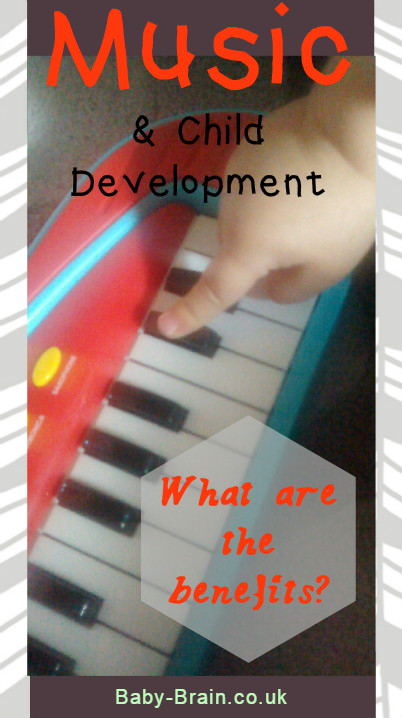 What are the benefits of babies and children Listening to music?
What are the benefits of babies and children Listening to music?
-
The Mozart Effect – listening to classical music enhances intelligence? The “Mozart Effect” is probably a well known term by now. This became a popular saying in the mid-90s after a study (Rauscher & Shaw) reported that students who listened to 10 minutes of Mozart showed improvements on spatial tasks. The effect was brief, only lasting 10-15 minutes. There has been a lot of research around this and results on the impact on “intelligence” and IQ vary. Later studies found only a minimal increase in IQ (1.5 points, this is really not very much) and limited improvements on tasks.
-
Listening to classical music for primary school children, though, has been shown to have some benefits. A project that introduced primary school children to classical music reported that “children listened to a range of music from a selection of well-known classical composers including Beethoven…Mozart…and Mendelssohn. The process of listening to live classical repertoire enabled children to enhance their listening skills and develop other skills needed for careful listening, including concentration and self-discipline.”
-
As this article here sums up, there is minimal evidence that listening to classical music increases IQ, so instead enjoy the research like the project above that shows children enjoy classical music and it can encourage listening and concentration skills
◊◊◊◊◊◊◊◊◊◊◊◊◊◊◊◊◊◊◊◊◊◊◊◊◊◊◊◊◊◊◊◊◊◊◊◊◊◊◊◊◊◊◊◊◊◊◊◊◊◊◊◊◊◊◊◊
How to use music with baby and toddlers
-
Interactive music making seems important. Learn to play an instrument together. I’m not talking about both taking up the guitar, I mean even something simple like shaking a maraca together. Take it in turns to make sounds. Respond to baby and mirror or echo their response. You could sing together too.
-
Singing is important for vocabulary development: “Singing songs teaches children about how language is constructed. When you sing, words and phrases are slowed down and can be better understood by your baby. Singing regularly will help your baby to build up a vocabulary of sounds and words long before they can understand the meaning”, according to this article from the BBC.
-
More on singing to baby: this article outlines some of the findings. It cites that babies are particularly responsive when the music comes from the parent directly, and singing along with a parent can help develop awareness and skills in reciprocal communication. Music and rhyme in nursery rhymes can impact on ability in spatial reasoning, which the article writes can enhance mathematical and scientific abilities.
-
The article continues, in addition to singing nursery rhymes add songs with actions and encouraging dancing to the music to help build balance, coordination, body awareness and rhythm skills.
-
Get creative with music making equipment. Use pots and pans, or make a simple shaker from an old plastic bottle filled with pulses, dried pasta or something that makes a noise. We made one using red lentils and tapioca (pictured left).
-
Look for local and free activities to get involved in. Local libraries where we are do baby singing sessions. They are about 30-45 minutes of singing nursery rhymes together in a big circle, using actions and sometimes props like colourful pieces of material to wave around and puppets (e.g. animal puppets for Old McDonald Had a Farm).
-
Enjoy listening to and experiencing the music with your child, rather than worrying if it’s the “right kind” of music or that it should be prescriptive somehow, e.g. you must listen to 10 minutes of Mozart a day in order to increase IQ. This is because the research is mainly reporting the benefits of music to be around skills of concentration, listening and discipline (among others).
References:
James Hudziak, M.D. et al. Cortical Thickness Maturation and Duration of Music Training: Health-Promoting Activities Shape Brain Development. Journal of American Academy of Child and Adolescent Psychiatry, December 2014
David Gerry, Andrea Unrau, Laurel J. Trainor. Active music classes in infancy enhance musical, communicative and social development. Developmental Science, 2012; 15 (3): 398
Laurel J. Trainor. Musical experience, plasticity, and maturation: issues in measuring developmental change using EEG and MEG. Annals of the New York Academy of Sciences, 2012; 1252 (1): 25
Rauscher FH, Shaw GL, Ky KN. (1993). Music and Spatial Task Performance. Nature, 365(6447):611.
The importance of physical activity for baby and infants
I found this nice page from the NHS on physical activity guidelines for children under 5 (walking and non-walking)
Baby containers
Often, it is very easy for baby to spend time being still or strapped in somewhere like, the high-chair, then maybe into the buggy for an outing, then when you get home, maybe into the cot for nap, then into the high-chair again for lunch, into the walker, swing, or bouncer…etc…etc. See this post here from Starfish Therapies for more about this “container shuffle”, as they call it (baby shuffles from one container to the next)
Ok… So How much physical activity do children under 5 years old need to do to keep healthy?
The NHS writes that it is important for babies and infants to be physically active every day for healthy growth and development.
Babies
Babies should be encouraged to be active from birth. Before your baby begins to crawl, encourage them to be physically active by reaching and grasping, pulling and pushing, moving their head, body and limbs during daily routines, and during supervised floor play, including tummy time. Once babies can move around, encourage them to be as active as possible in a safe, supervised and nurturing play environment. For more ideas, see Keeping kids active.
Toddlers
Children who can walk on their own should be physically active every day for at least 180 minutes (3 hours). This should be spread throughout the day, indoors or outside. The 180 minutes can include light activity such as standing up, moving around, rolling and playing, as well as more energetic activity like skipping, hopping, running and jumping. Active play, such as using a climbing frame, riding a bike, playing in water, chasing games and ball games, is the best way for this age group to be physically active.
All children under 5 years old
Children under 5 should not be inactive for long periods, except when they’re asleep. Watching TV, travelling by car, bus or train or being strapped into a buggy for long periods are not good for a child’s health and development
Hah – don’t think my Little Lovely would qualify as being inactive for long periods, he is far too busy exploring and needing to pick up everything he sees to be doing that.
There are also two nicely set out downloads of Physical Activity Guidelines for under 5s who are not yet walking here, and under 5s capable of walking here.
Examples of physical activity for children who are not yet walking includes:
-
‘Tummy time’ – this includes any time spent on the stomach including rolling and playing on the floor
-
Reaching for and grasping objects, pulling, pushing and playing with other people
-
‘Parent and baby’ swim sessions
What are the benefits of movement?
• Develops motor skills
• Improves cognitive development
• Contributes to a healthy weight
• Enhances bone and muscular development
• Supports learning of social skills
What are the benefits of being active for at least 180 minutes each day?
• Improves cardiovascular health
• Contributes to a healthy weight
• Improves bone health
• Supports learning of social skills
• Develops movement and co-ordination

